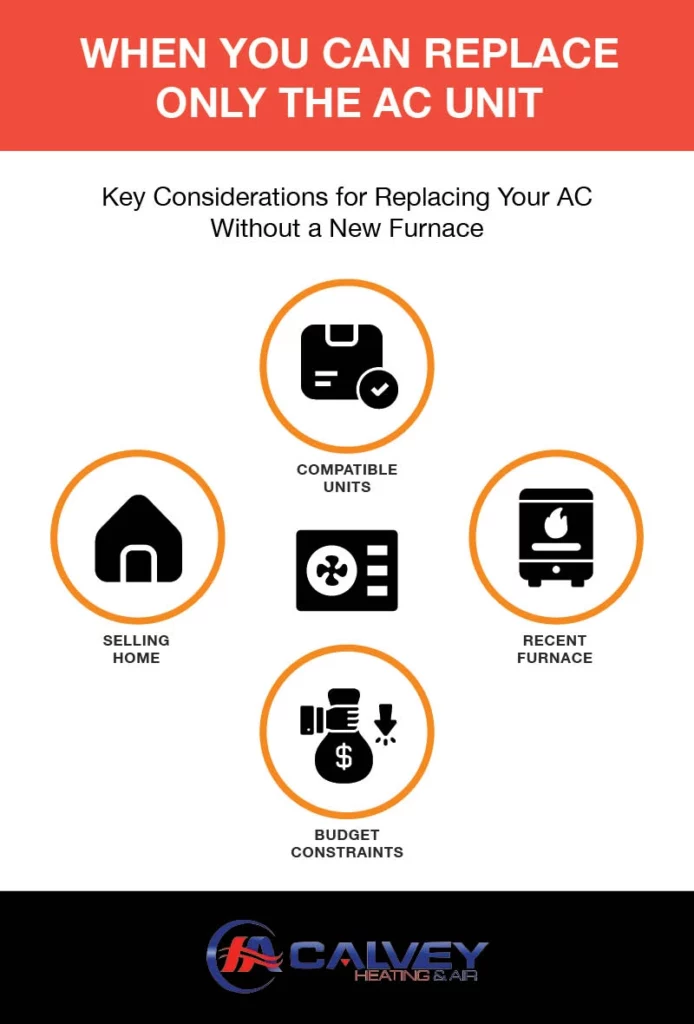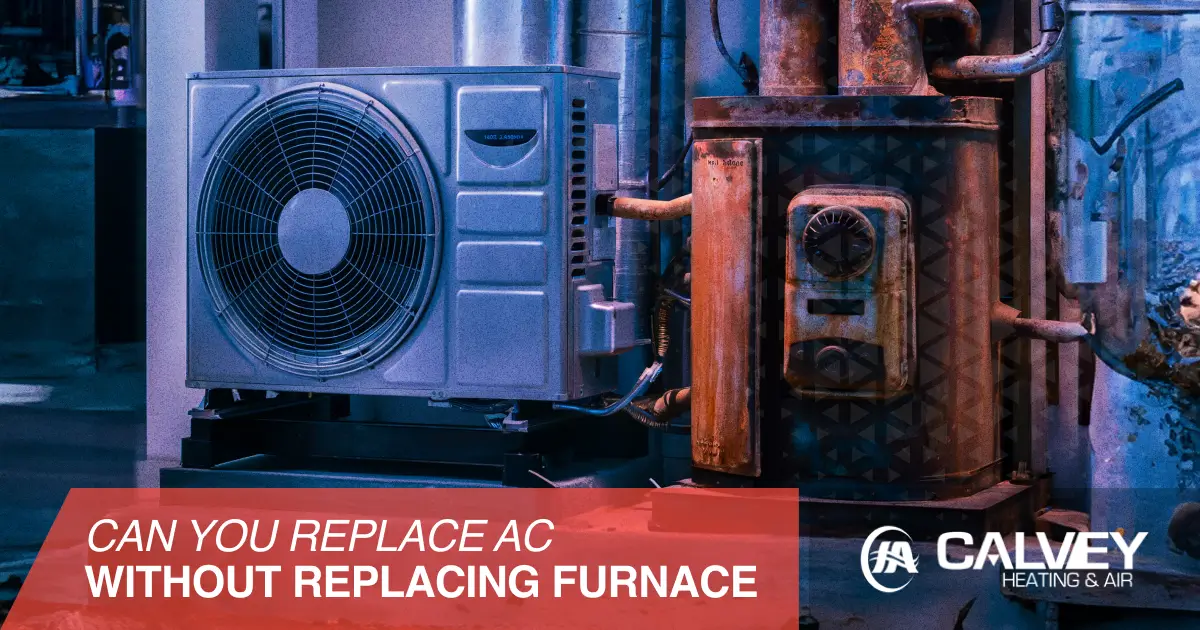It’s possible to replace your AC unit without replacing the furnace, but making the decision involves a few strategic considerations.
Replacing your AC unit when it finally wears out is essential for ensuring a cool and comfortable respite in your home during California’s sweltering summers. While your furnace may not be at the forefront of your mind during the peak cooling season, your home may benefit from the comfort, energy efficiency, and other benefits of replacing both.
Compatibility of AC Units and Furnaces
Manufacturers often design furnaces and AC units to operate together. In most HVAC setups and systems, these matching units are interconnected and work in tandem to regulate temperature, airflow, and air quality throughout your home.
Modern HVAC units typically come as matching sets with compatible interior components. When paired, these AC units and furnaces can optimize system performance and efficiency. While AC units and furnaces function independently to an extent, setups with mismatched usage and wear, efficiency ratings, technological advances, and other features can limit performance.
When Can You Replace Only the AC Unit

Under certain circumstances, replacing just your AC unit without replacing the furnace can be an advantageous strategy.
Compatible units
If your existing furnace is compatible with your new AC unit and meets current California HVAC efficiency standards, it may not be necessary to replace both systems. While replacing your furnace at the same time may optimize the system’s overall efficiency, replacing your existing AC with a similar model with compatible components and configurations can offer comparable efficiency.
Recent furnace installation
If your furnace is relatively new and 5 years old or less, in good condition, and still under warranty, replacing only the AC unit can be a practical choice. With proper maintenance, some furnaces can last between 15 and 30 years. In comparison, AC units typically last between 10 and 15 years, meaning some systems may cycle one or two AC units before replacing the furnace.
Budget constraints
If certain factors limit your budget, it’s best to prioritize replacing the AC unit if it’s largely responsible for high energy consumption, poor HVAC performance, and repair costs. Replacing the units separately may cost slightly more in the long term, but spacing out your investments can make replacement costs more accessible and manageable.
Selling your home
Replacing your AC and furnace may not be cost-effective if you plan to sell your home within the next year or two. An HVAC system with an AC unit and furnace both under 10 years old and functioning reasonably well should be sufficient to sell your home without losing value. If your AC needs urgent or significant repairs, however, it’s likely worth replacing.
The value of a brand-new system may not factor into the home’s sale price, so investing in both a furnace and AC unit may result in a loss if you sell your home shortly after the replacements.
Drawbacks of Not Replacing Both
While replacing only the AC unit can save immediate costs, it can also present drawbacks in the long term:
- Mismatched efficiency ratings: Old furnaces may not match the high Seasonal Energy Efficiency Ratio (SEER) ratings of new AC units. Operating mismatched units can reduce system efficiency and increase energy bills.
- Limited compatibility: Outdated furnaces may not support advanced features and technology of modern AC models, such as variable-speed motors or smart technology integration.
- Maintenance and repair costs: Furnaces generally require more maintenance and repairs as they age. The strain of matching a modern AC unit can increase and compound wear on an older furnace, leading to high service costs.
- Poor system longevity: Mismatched efficiency, unsupported technology, and increased wear can accelerate wear on both the furnace and AC unit.
When It Makes Sense to Replace Both
Although it presents a higher overall investment than only replacing one unit, updating your entire HVAC setup can offer significant benefits. Several scenarios make replacing both units a smart choice that offers long-term cost savings.
Age and condition
If both the AC unit and furnace are more than 10 years old, replacing both can maximize efficiency. While furnaces can last up to 30 years, some units may start losing efficiency and incurring higher repair costs after 10 years, especially as they’re typically no longer under warranty protection.
Installation cost
Labor represents a portion of the overall replacement cost. Since replacing both the furnace and AC unit is typically more time-effective for HVAC technicians than separate replacements and only requires one dispatch fee, the installation labor likewise becomes more cost-effective for the homeowner.
Enhanced performance
Upgrading to an entirely new system can allow you to leverage modern HVAC technology, such as top-end efficiency and smart home integration. These features can improve performance, enhance comfort and convenience, and provide long-term savings.
What to Consider Before Making a Decision
The decision to replace your furnace and AC unit together involves a few important considerations.
System compatibility
Consult with an HVAC technician to assess the compatibility of your existing furnace with your new AC unit in terms of capacity, efficiency, and performance. Our technicians at Calvey Heating and Air can evaluate your home’s needs to customize an HVAC solution.
Warranty coverage
If your furnace’s warranty is expired, repairs and emergency breakdowns can pose significant inconvenience and expense. Some manufacturers also won’t honor your furnace’s warranty if you match it with an unapproved and incompatible AC unit as they can strain each other and cause undue wear. Check your warranty to verify its conditions before making a decision.
Incentives and rebates
Research the incentives and rebates available to homeowners. You may qualify for programs that offer federal tax credits for HVAC upgrades, such as the Energy Efficient Home Improvement Credit through the Inflation Reduction Act.
Financial considerations
Consider your budget, financing options, and current repair costs to determine a cost-effective solution. If your repair and maintenance costs are getting excessively high or frequent, the investment of replacing both can decrease and even offset lifetime operational costs.
Alternative systems
If both your AC unit and furnace are due for a replacement, it may be worth investigating alternative HVAC setups. Heat pumps and ductless mini-splits, for instance, can provide efficient all-in-one heating and cooling as well as other modern technology and features to optimize comfort and performance.
Contact Calvey Heating and Air for Efficient HVAC Performance in California
For central AC installation, furnace replacements, and other HVAC services, rely on our team at Calvey Heating and Air. Serving San Jose, South Bay, San Francisco, and more, we offer reliability, transparency, and high-quality workmanship to our customers. Contact us at Calvey Heating and Air for a free estimate or to schedule a service.
Frequently Asked Questions
How can I ensure compatibility between my AC unit and furnace?
Consult with a licensed HVAC technician from Calvey Heating and Air to evaluate your home’s cooling and heating needs and to determine the capacity, efficiency, and other compatibility factors between your furnace and AC unit.
Are there financing options available for replacing my HVAC units?
Homeowners can take advantage of flexible financing when they replace their HVAC units or entire system with Calvey Heating and Air.
What are the signs that it’s time to replace both the AC unit and furnace?
It may be time to replace both units if you notice these signs:
- Aging units
- High energy bills
- Uneven cooling and heating
- Unreliable performance
- Frequent repairs


